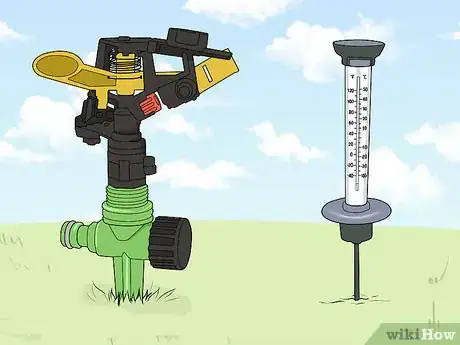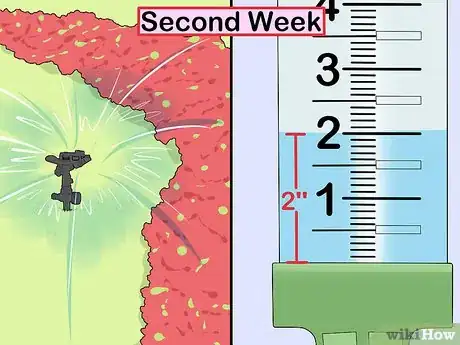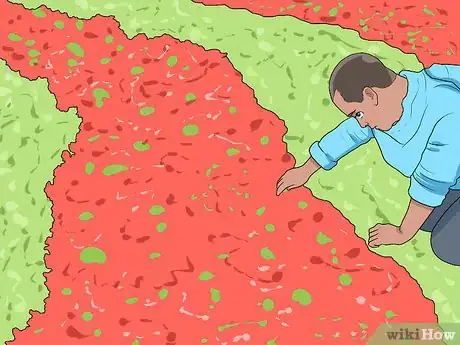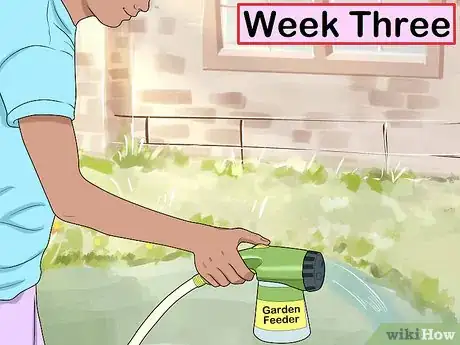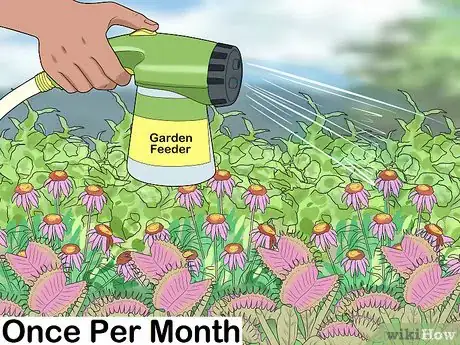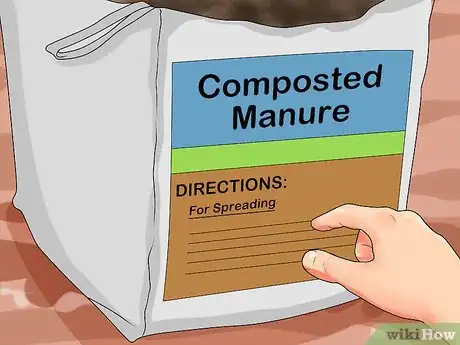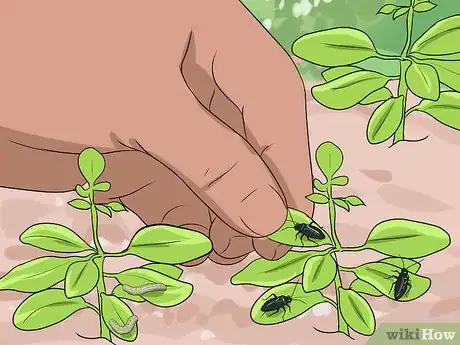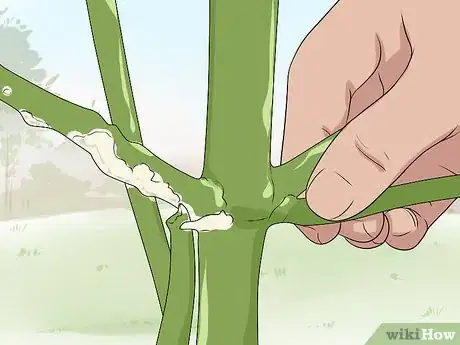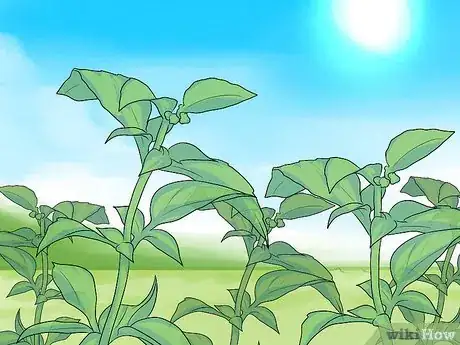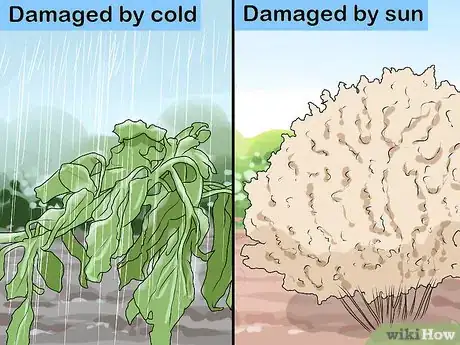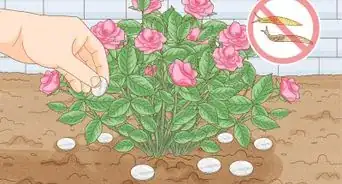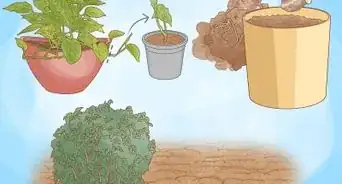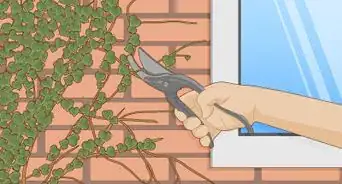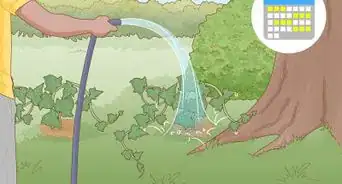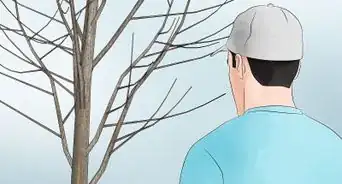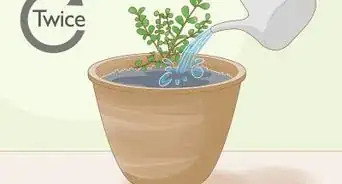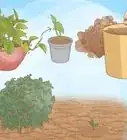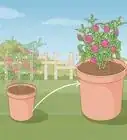This article was co-authored by Grant Wallace. Grant Wallace is a Landscaper and Owner of Grantlanta Lawn in Atlanta, Georgia. With over seven years of experience, he specializes in lawn maintenance and landscape installation. In 2012, he earned his BA from the University of West Georgia. Grant has been profiled in Shoutout Atlanta, Canvas Rebel, and Voyage ATL.
This article has been viewed 186,732 times.
It's a shame to see dying landscape plants, shrubs, and trees that sometimes cost hundreds to thousands of dollars, suffering from neglect or poor care. Rather than accept the loss and start over next season, you can save your landscaping investment, with very little effort and cost, over about a month.
Steps
Setting up an Irrigation System
-
1Assess your plants' watering needs. Under-watering is a far more common problem than overwatering. As a general rule, each square foot of the landscape needs about 2–3 US quarts (2,000–3,000 ml) of water weekly. Or, about 20 liters (5.3 US gal) per square meter. Put another way, it needs to receive at least 1 inch (2.5 cm) of rain or water each week.
- Most trees need about 2–3 US quarts (2,000–3,000 ml) of water once per week for every foot in height (spread evenly around its root system). Thus, a 20 feet (6.1 m) tall tree should get 40–60 US quarts (38,000–57,000 ml) of water once per week. Or, about 18 liters (4.8 US gal) per week for a 6-meter tree.[1]
-
2Buy a lawn sprinkler, a garden hose, an automatic water timer, and a rain gauge. You can get these at most hardware stores or garden centers. This is a small investment compared to replacing thousands of dollars in landscaping. Most people fail in maintaining their landscape because they try watering all plants by hand. This usually leads to gross under-watering because of wrongly estimating watering needs. It is also massively time-consuming.
- Most sprinkler systems will hook up directly to your hose, making for simple installation. More complex underground sprinkler systems will usually need to be installed by a professional.[2]
Advertisement -
3Set up the rain gauge in the path of the sprinkler. This will allow you to check how much water your system is putting out. Check it every 15 minutes. Once it hits the 1-inch (2.5-cm) mark, note how much time elapsed. Depending on your home's water pressure and your sprinkling system, this can take anywhere from 30 to 120 minutes.[3]
-
4Set the timer for the time needed to get 1 inch (2.5 cm) of water. After you’ve determined how long it takes for your landscape to get 1 inch (2.5 cm) of water, you can optimize your irrigation system. Setting up an automatic timer will shut off the water so you don't waste it. This also saves you many hours compared to hand watering.
-
5Water the landscape so it gets 3 inches (7.6 cm) the first week. To do this, water 1 inch (2.5 cm) every 48 hours for the first week. During this same period, trees should get 6–9 US quarts (6,000–9,000 ml) of water for every foot (about 3 liters per meter) in height, spread evenly around the roots.[4]
- Water your landscape on a regular schedule even if it looks like it may rain. It's unlikely you will over-water your garden even if it does rain.
-
6Water the landscape so it gets 2 inches (about 5 cm) the second week. To do this, water 1 inch (25mm) every 72 hours for the second week. At this point, you should notice your landscape greening up quite nicely. Trees should get 4–6 US quarts (4,000–6,000 ml) of water for every foot in height, spread evenly around the roots.
- For each week thereafter, water once per week so the landscape gets 1 inch (2.5 cm) per week.
-
7Check your plants for under- and over-watering regularly. If the problem is overwatering, you need to make adjustments for your soil to drain better. Either create elevation for water run off or add organic mixtures to your soil. Be sure to monitor how much water your plants need during different seasons so you can adjust their water schedules accordingly.
Fertilizing Your Landscape
-
1Get nutrients for your landscape at week three. The second most common cause of dying landscape plants is inadequate plant nutrition. In other words, fertilize your plants. Inexpensive systems for applying fertilizer are available at most hardware stores or garden centers. Buy a garden feeder that attaches to your lawn sprinkler. The garden feeders usually come packaged with a popular brand of balanced liquid fertilizer.
- Follow the fertilizer package directions and apply balanced liquid fertilizer to your landscape using the garden feeder that attaches to your sprinkler.[5]
-
2Fertilize once per month thereafter. It’s important to feed your plants well during the growing season, if you’re going to save them. Feed them once a month unless the package directions indicate otherwise.[6]
-
3Amend your soil by applying compost or composted manure. This step should not be ignored. Fertilizer is only a short term solution for immediate rescue. Building the soil organically is a must. It varies the nutrients in the soil and keeps your plants going strong.[7]
- Compost or manure can be obtained at garden centers or hardware stores in 40-pound bags for under $3 per bag (USD).
-
4Follow directions for spreading the compost on the bag. If the directions aren't printed, a general rule is one bag for every 10 square feet of planted landscape (about 1 bag per square meter).[8]
- If your landscape is mulched, rake away the mulch before applying the compost. Then replace the mulch.
-
5Apply compost or manure only once per year. It's best done in the spring in subsequent years, and can be applied more lightly, at the rate of 1 bag every 20 square feet (1 bag per 2 square meters).[9]
Diagnosing Dying Plants
-
1Inspect your plants for insects. Not only do bugs eat leafy plants, they can also spread diseases between plants. If your plants are dying, take a close look and try to spot insects that might be causing problems. Try removing them by hand if you can, otherwise ask someone at your home improvement store for advice on insecticides or other products you can use.
- Wear long pants and a long sleeved shirt to protect yourself from bugs and ticks.
- If you need to get rid of pests, make sure the insecticides you use won’t damage your plants.
-
2Check for diseases. A visual inspection of your plants is usually enough to figure out if they’re diseased or not. Look for spots of fungus or dark stains, especially around the trunks of trees and stems of plants.
- Many diseases that affect plants spread quickly. If you find a plant that’s diseased, you can treat it with fungicide, or remove the plant from your landscape and burn it.[10]
- Fungicide sprays can be found at gardening supply stores.
-
3Give your plants just the right amount of sun. If your plants are wilting, they might not be getting enough sun. It’s possible they spend too much time in the shade, so keep an eye out throughout the day to check this. It’s also possible your plants are bunched up together, meaning the smaller ones are obscured by the larger plants and sunlight can’t get to them.
- Plants can also get too much sun and end up sunburned. Check the leaves. If there are brown spots (and they haven’t just bean eaten by bugs), they may be sunburned. Try moving the plants to a more shaded area.
-
4Save plants damaged by wind and cold. If you’ve just transplanted a tree or plant into a new area, it might be vulnerable to damage from cold or harsh weather. If the plant is particularly droopy, or you notice branches and leaves have been ripped off, you’re looking at weather damage. Cover the plant in a horticultural fleece during the day to protect it either until it adapts or the weather improves.[11]
Expert Q&A
Did you know you can get expert answers for this article?
Unlock expert answers by supporting wikiHow
-
QuestionCan a plant recover from wilting?
 Lauren KurtzLauren Kurtz is a Naturalist and Horticultural Specialist. Lauren has worked for Aurora, Colorado managing the Water-Wise Garden at Aurora Municipal Center for the Water Conservation Department. She earned a BA in Environmental and Sustainability Studies from Western Michigan University in 2014.
Lauren KurtzLauren Kurtz is a Naturalist and Horticultural Specialist. Lauren has worked for Aurora, Colorado managing the Water-Wise Garden at Aurora Municipal Center for the Water Conservation Department. She earned a BA in Environmental and Sustainability Studies from Western Michigan University in 2014.
Professional Gardener
-
QuestionCan plants recover from transplant shock?
 Lauren KurtzLauren Kurtz is a Naturalist and Horticultural Specialist. Lauren has worked for Aurora, Colorado managing the Water-Wise Garden at Aurora Municipal Center for the Water Conservation Department. She earned a BA in Environmental and Sustainability Studies from Western Michigan University in 2014.
Lauren KurtzLauren Kurtz is a Naturalist and Horticultural Specialist. Lauren has worked for Aurora, Colorado managing the Water-Wise Garden at Aurora Municipal Center for the Water Conservation Department. She earned a BA in Environmental and Sustainability Studies from Western Michigan University in 2014.
Professional Gardener
-
QuestionHow do I save my plant from dying?
 Lauren KurtzLauren Kurtz is a Naturalist and Horticultural Specialist. Lauren has worked for Aurora, Colorado managing the Water-Wise Garden at Aurora Municipal Center for the Water Conservation Department. She earned a BA in Environmental and Sustainability Studies from Western Michigan University in 2014.
Lauren KurtzLauren Kurtz is a Naturalist and Horticultural Specialist. Lauren has worked for Aurora, Colorado managing the Water-Wise Garden at Aurora Municipal Center for the Water Conservation Department. She earned a BA in Environmental and Sustainability Studies from Western Michigan University in 2014.
Professional Gardener
Warnings
- If your community is restricting water use because of drought, you might need to be more creative to get your landscape needed water.⧼thumbs_response⧽
Expert Interview

Thanks for reading our article! If you'd like to learn more about landscape plants, check out our in-depth interview with Grant Wallace.
References
- ↑ https://extension.tennessee.edu/publications/Documents/W175.pdf
- ↑ https://www.familyhandyman.com/landscaping/how-to-install-an-irrigation-system-in-your-yard/view-all/
- ↑ https://www.todayshomeowner.com/calculating-lawn-irrigation-costs/
- ↑ https://www.irrigationtutorials.com/irrsch.htm
- ↑ http://www.gardeners.com/how-to/feed-your-plants/5703.html
- ↑ http://www.gardeners.com/how-to/feed-your-plants/5703.html
- ↑ http://www.gardeners.com/how-to/feed-your-plants/5703.html
- ↑ http://www.gardeners.com/how-to/feed-your-plants/5703.html
- ↑ http://www.gardeners.com/how-to/feed-your-plants/5703.html
About This Article
It’s a shame to see your landscape plants dying, but if you figure out what’s wrong, you may still be able to rescue them. If your plants have spots or dark stains on them, they may be diseased. You can use fungicide spray to treat them and prevent the fungus from spreading. If your plants have dry, brown spots, they’re probably getting too much sun. Try digging them up and replanting them in a more shaded area. On the other hand, plants that are drooping may need to be moved to an area with more sunlight. To keep your landscape plants healthy in the long run, water each square foot with at least 2-3 quarts of water a week. If you’re not sure how much water they’re getting, purchase a rain gauge to help keep track. Besides watering your plants, you should fertilize them once a month to ensure they’re getting the right nutrients. To learn how to set up a sprinkler system for your plants, read more from our Gardening co-author!


